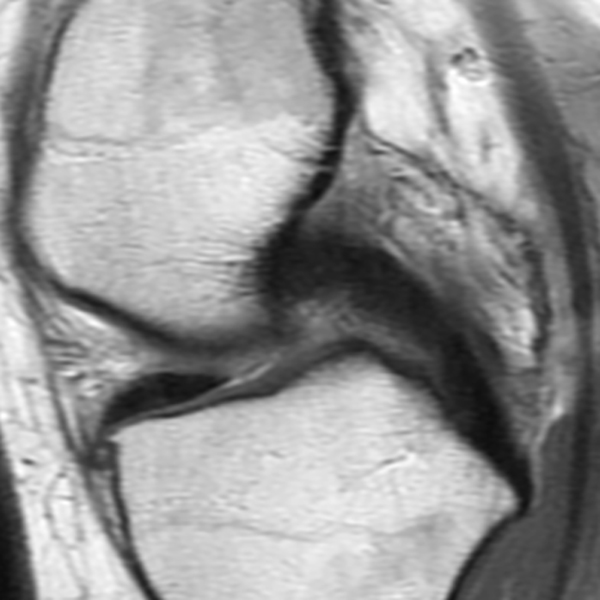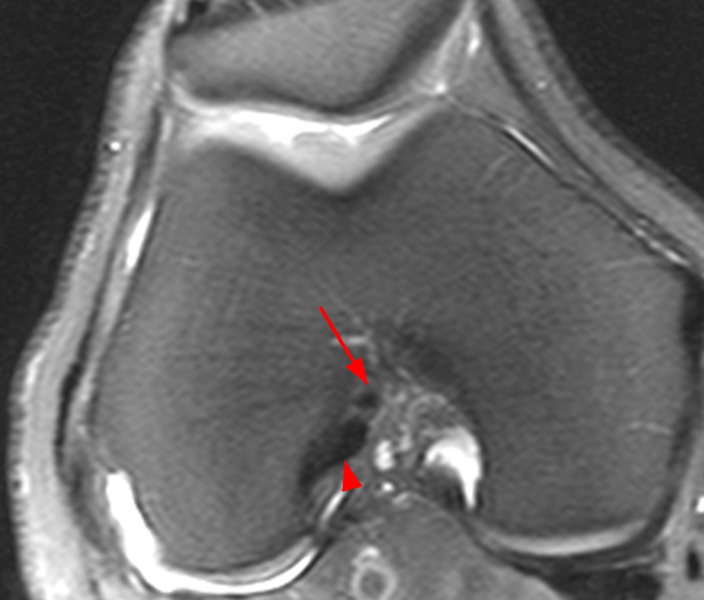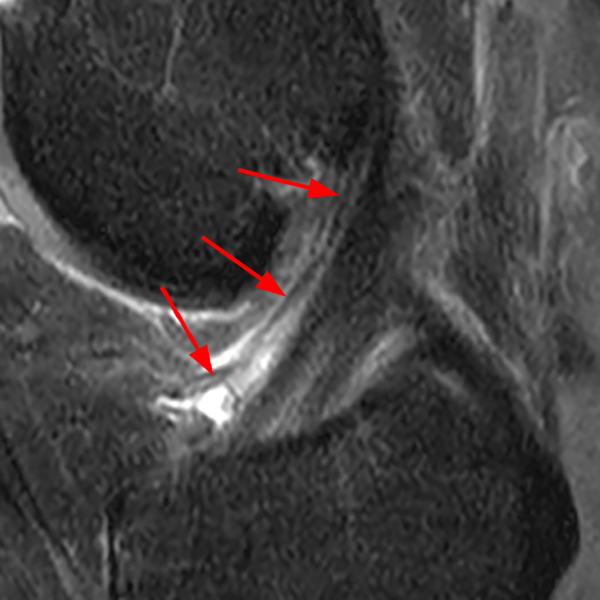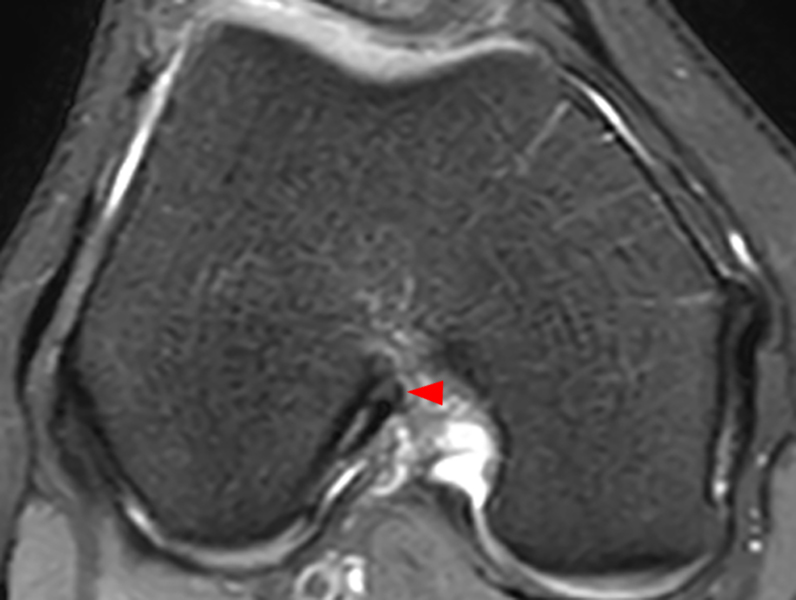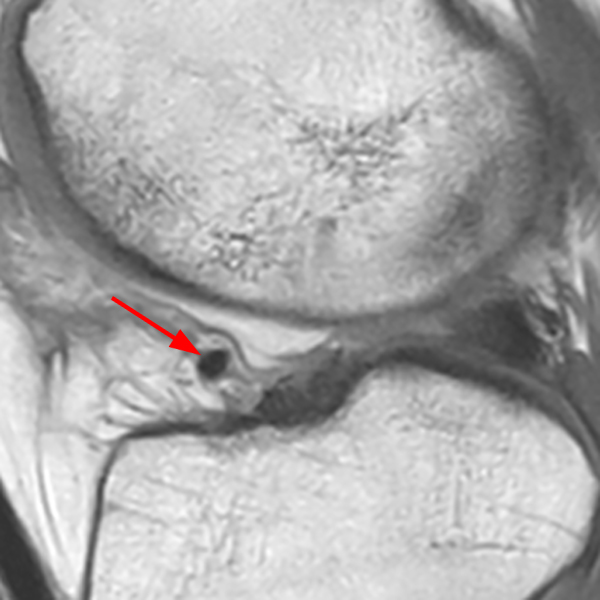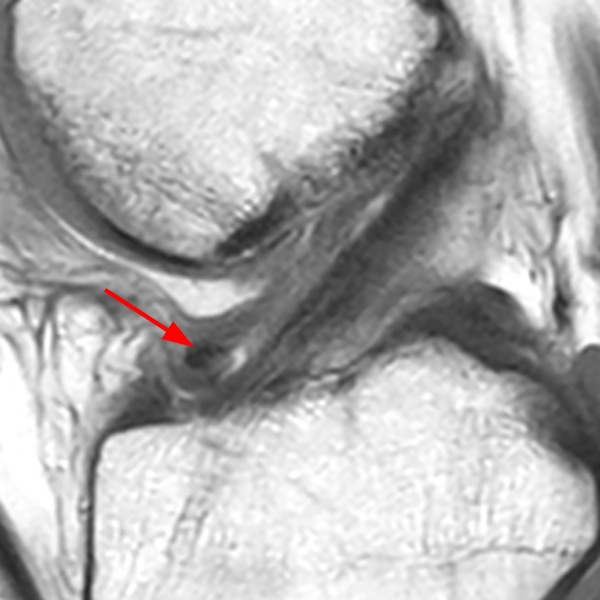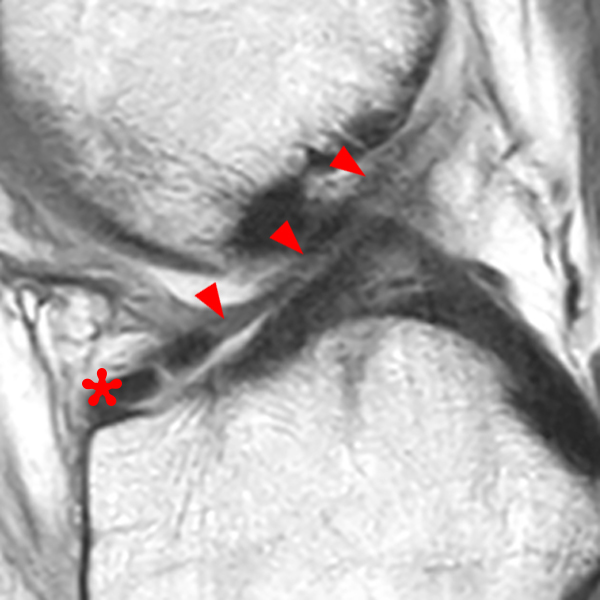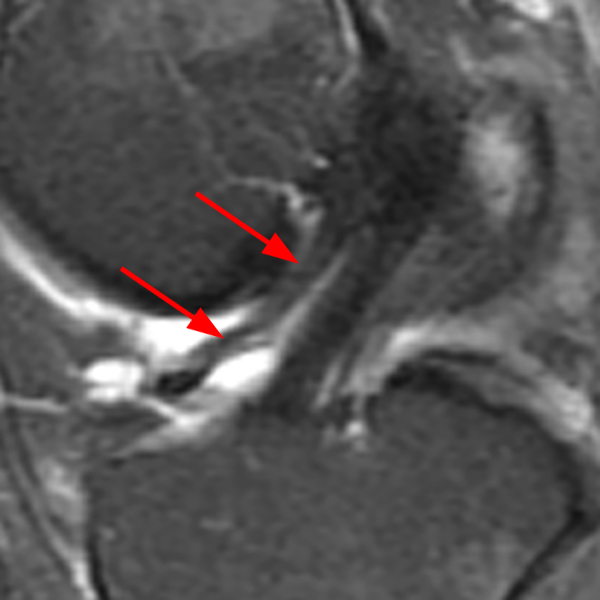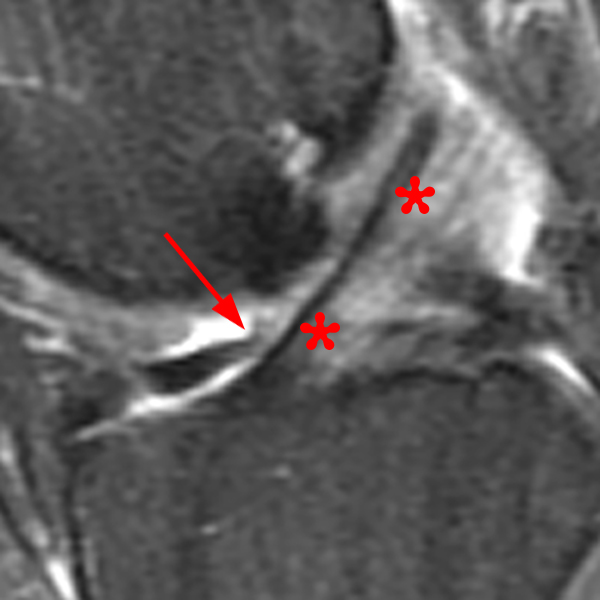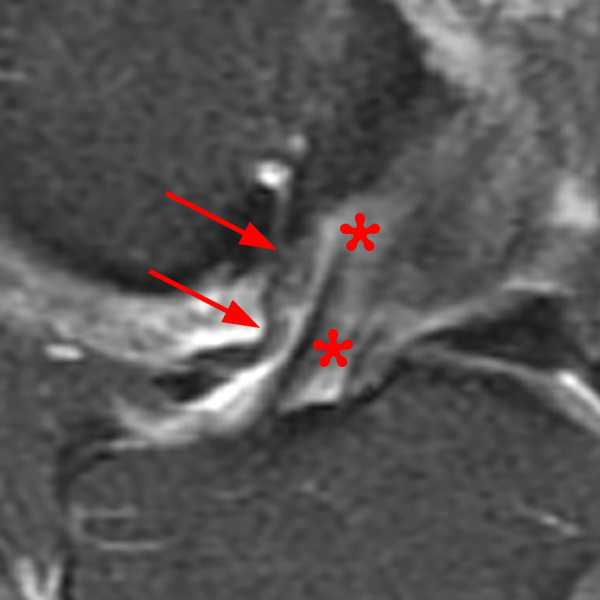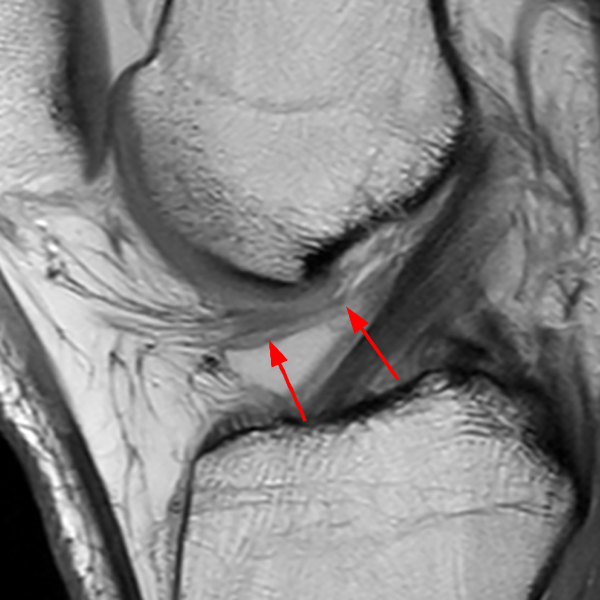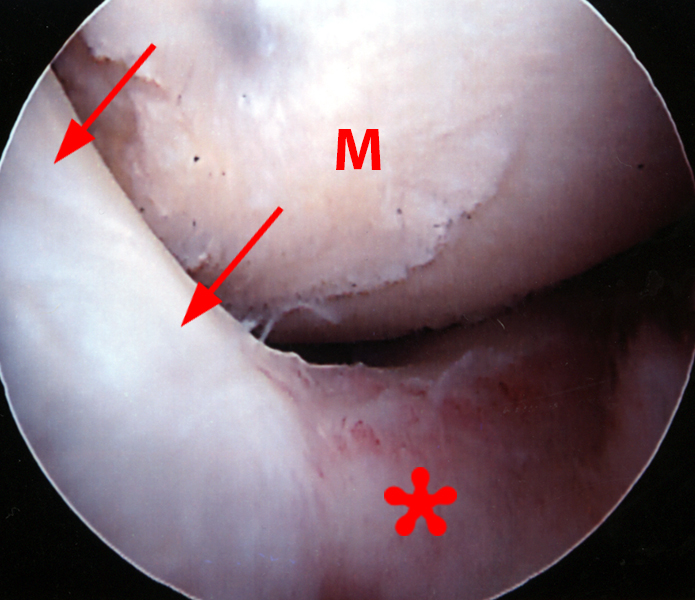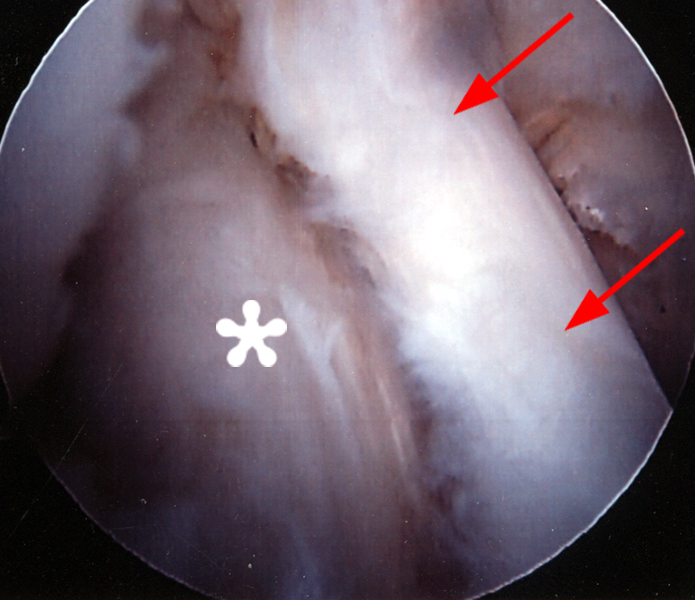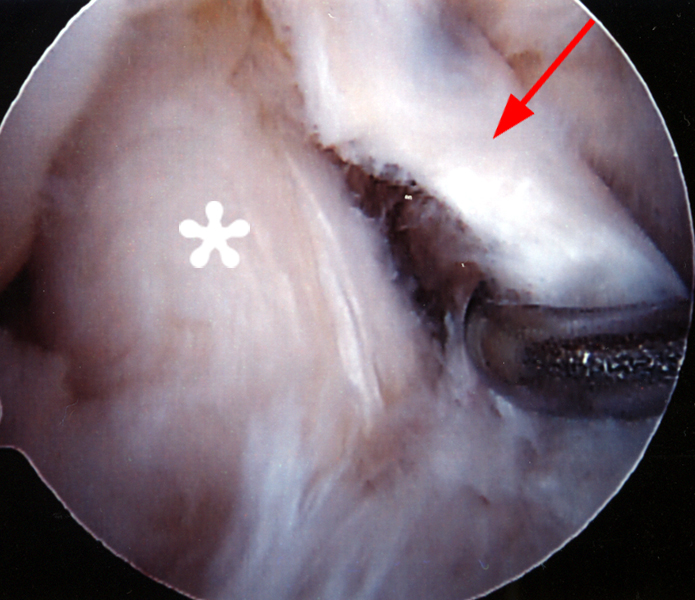Clinical History: A 48-year-old female presents with knee pain following an injury while running. Consecutive proton density-weighted sagittal images (1a,b) near the root of the anterior horn of the medial meniscus and a fat-suppressed proton density-weighted axial (1c) image are provided. What are the findings? What is your diagnosis?
Findings
Figure 2:
The initial proton density-weighted sagittal image (2a) demonstrates the anterior horn of the medial meniscus (asterisk) near its root. On the next more lateral sagittal image (2b), a linear structure (arrows) is seen coursing from the root of the anterior horn of the medial meniscus cephalad along the anterior aspect of the ACL (arrowheads). The variant structure (arrow) is visible anterior to the ACL (arrowhead) on the fat-suppressed proton density-weighted axial image (2c).
Diagnosis
The anterior meniscofemoral ligament of the medial meniscus, an anatomical variant.
Introduction
The meniscofemoral ligaments are widely recognized as structures which connect the posterior root of the lateral meniscus to the medial femoral condyle near the intercondylar notch.1 The term ligament is a misnomer, since the structures do not extend from bone to bone as is customary for a ligament. The commonly seen meniscofemoral ligaments include the Ligament of Humphrey, which passes anterior to the PCL, and the ligament of Wrisberg, which passes posterior to the posterior cruciate ligament (PCL).2,3 These “ligaments” are quite common, with the prevalence of at least one typically reported at over 90%.4 They are felt to be anatomically important structures, playing a role in the proper dynamic stability and contact mechanics of the posterior horn of the lateral meniscus during knee motion.5
Because of their position relative to the PCL, the Humphrey ligament (3a,b) is frequently referred to as the anterior meniscofemoral ligament and the Wrisberg ligament is referred to as the posterior meniscofemoral ligament. Yet these are obviously both posterior structures in the knee.
The variant depicted in this Web Clinic is under-recognized and far less common than the ligaments of Humphrey and Wrisberg, with most large studies demonstrating the variant in less than 1% of arthroscopies.6,7 This is a true anterior structure, and thus has been termed by various authors the anterior meniscofemoral ligament of the medial meniscus, the anteromedial meniscofemoral ligament (of the anterior horn of the medial meniscus), and as an anomalous insertion of the medial meniscus.8
Relevant anatomy
There are four generally accepted patterns of attachment of the root of the anterior horn of the medial meniscus.9 The most common (59%) insertion is found at the flat intercondylar region of the tibial plateau (Figure 4). Less common attachment sites include the downward sloping region between the medial tibial plateau and the intercondylar region and along the anterior slope of the tibial plateau. The least common pattern (3%) includes no firm bony attachment, and has been further subdivided into attachments of the anterior horn of the medial meniscus to the ACL, the transverse ligament, and the coronary ligament.10 Cha et al. recognized that the attachment pattern to the ACL includes those that insert directly into the ACL and those that attach anterior to the ACL at the intercondylar notch.11 The anterior meniscofemoral ligament of the medial meniscus is thought to represent the rare variation in which the anterior horn of the medial meniscus attaches to the intercondylar notch anterior to the ACL (Figure 5).
Figure 4:
Anterior view of the proximal tibia and fibula demonstrates the most common anterior root attachment of the medial meniscus (asterisk), in which fibers of the anterior horn attach firmly to the flat area of the anteromedial tibial plateau. The transverse ligament (TL), anterior cruciate ligament (ACL), posterior cruciate ligament (PCL), and ligament of Wrisberg (LW) are also labeled.
Figure 5:
Axial view of the knee with the femur removed (left) and medial view of the knee with the medial femoral condyle removed (right) shows the anterior meniscofemoral ligament of the medial meniscus (AMLMM) anterior to the anterior cruciate ligament (ACL) with attachment at the anterior horn of the medial meniscus. The transverse ligament (TL), posterior cruciate ligament (PCL), and ligament of Wrisberg (LW) are also labeled.
MRI and Arthroscopic Appearance
This anterior meniscofemoral ligament of the medial meniscus (AMLMM) is relatively rare, found in the range of 0.44% to 0.77% of knees in arthroscopic and MRI studies.12 Yet this variant will almost certainly be encountered in a typical practice performing orthopaedic MRI, and thus recognition of the variant and its possible pitfalls is important.
The AMLMM is typically best visualized on oblique sagittal MR images through the knee. It is of variable thickness but is invariably smaller in caliber than the adjacent ACL. The variant is of low signal intensity on T1 or T2-weighted images, similar in signal to the ACL and slightly higher in signal intensity than the normal meniscus. The AMLMM can be consistently followed from its attachment to the anterior horn of the medial meniscus to its attachment to the intercondylar notch anterior to the ACL. The large majority of reported cases of the AMLMM found an absence of the normal anterior root attachment of the medial meniscus to the tibial plateau, and this can be demonstrated on MRI via fluid signal lying in the region of the typical tibial root attachment (Figure 6). Arthroscopic studies have further demonstrated hypermobility of the anterior horn of the medial meniscus in such patients, presumably related to the lack of a firm osseous attachment to the proximal tibia.
Figure 6:
Fat-suppressed proton density-weighted sagittal images (6a,b,c) demonstrate an AMLMM (arrows) arising from the root of the anterior horn of the medial meniscus (asterisk 6a) and coursing cephalad anterior to the ACL. Note fluid signal intensity subjacent to the root on 6a, indicating no firm osseous attachment of the anterior root. The variant structure (arrowhead) is identified attaching to the intercondylar notch anterior to the ACL on a corresponding fat-suppressed proton density-weighted axial view (6d).
Although some reports have demonstrated no additional connections of the AMLMM beyond the anterior root and the intercondylar notch13, larger studies have reported multiple cases in which the variant also attaches to the transverse meniscal ligament (Figure 7).
Figure 7:
Consecutive proton density-weighted sagittal images from lateral to medial demonstrate the low signal intensity transverse meniscal ligament (arrows 7a,b,c) extending from the midline of the joint to the root of the anterior horn of the medial meniscus (asterisk 7d), where it blends with an AMLMM (arrowheads 7d) that courses cephalad anterior to the ACL.
The AMLMM, once properly recognized, rarely presents a diagnostic dilemma. But to the uninitiated, the variant can be a MRI pitfall, as on coronal images, the AMLMM can mimic a displaced meniscal fragment as it leaves the anterior horn (Figure 8).
Figure 8:
A fat-suppressed proton density-weighted sagittal image (8a) demonstrates a prominent AMLMM (arrow) as it courses cephalad anterior to the ACL. On (8b) the coronal fat-suppressed proton density-weighted image, the variant (arrow) may be confused with a displaced meniscal fragment as it extends away from the anterior horn.
A second pitfall arises in the rare cases where the AMLMM appears lax or irregular (Figure 9). In such patients, recognition of the variant as a separate anatomical structure precludes the mistake of calling it a partial ACL tear.
Figure 9:
Consecutive fat-suppressed proton density-weighted sagittal images demonstrate an AMLMM arising near the root of the anterior horn of the medial meniscus (arrow 9a). The variant (arrow 9b) appears abnormally lax on the adjacent sagittal slice. The ACL (asterisks) lies posterior to the variant and is intact.
The infrapatellar plice, or ligamentum mucosum, may be confused with an AMLMM, as it has a similar attachment to the intercondylar notch anterior to the proximal ACL (Figure 10).14 However, the infrapatellar plica tends to be less well-defined, and it attaches distally to the infrapatellar fat pad or the lower pole of the patella, clearly distinct from the meniscal attachment of an AMLMM.
Figure 10:
Consecutive proton density-weighted sagittal images through the central knee demonstrate an infrapatellar plica (arrows). Similar to an AMLMM, this structure arises from the intercondylar notch anterior to the ACL. However, it is less well-defined than an AMLMM and has no connection to the medial meniscus. In this example, the plica terminates within the infrapatellar fat pad.
The AMLMM is identified arthroscopically via the anterior approach. When present, it is noted to be distinct from the infrapatellar plica and clearly arises from the anterior horn of the medial meniscus. Extension to its attachment to the intercondylar notch anterior to the ACL is also readily apparent (Figure 11, 12).
Figure 11:
Photos from the 30 degree arthroscope in a patient with an AMLMM. The initial photo (11a) demonstrates the variant structure (arrows) arising from the root of the anterior horn of the medial meniscus (red asterisk). The medial femoral condyle (M) is indicated. Additional photos (11b,c) demonstrate the AMLMM (arrows) coursing cephalad anterior to the ACL (white asterisks). The normal ACL is well visualized with the variant pulled to the side (11c). Photos courtesy of Christian Anderson, MD, Tennessee Orthopaedic Alliance.
Figure 12:
Video from arthroscopy of another patient with the AMLMM. The arthroscopic probe can be seen about the variant structure, and its connection to the anterior horn of the medial meniscus is readily apparent. Video courtesy of Christian Anderson, MD, Tennessee Orthopaedic Alliance.
Discussion
The AMLMM is a variant anatomical structure that is under-recognized by both radiologists and orthopaedic surgeons. It extends from the root of the anterior horn of the medial meniscus to attach to the intercondylar notch anterior to the ACL. Although one study (Nakajima et al.) demonstrated histologic features of a meniscus, the majority of studies have confirmed fibrous connective tissue consistent with a ligament. The difference may be related to the site of biopsy, as the tissue may appear more meniscoid closer to the meniscal root. On MRI, the AMLMM demonstrates low signal intensity similar to the ACL and slightly higher in signal intensity than a normal meniscus.
Most authors agree that the AMLMM is not typically a source of knee pain, though hypermobility of the anterior horn of the medial meniscus is associated with the variant, and Kim reported that patients with the variant tended to have larger medial menisci. It is generally accepted that the AMLMM likely plays a role in load transmission, stability and kinematics of the medial meniscus and as such, should not be routinely resected. The stabilization properties are likely significant since patients with this variant lack the usual firm attachment to the proximal tibia.
Rare reports (Nakajima et al.) have noted resolution of anterior knee pain following resection of the variant, and there is a case report of a longitudinal tear of the anterior horn of the medial meniscus adjacent to the attachment of the AMLMM in a patient who suffered an ACL tear.15 In this report, Hamada et al. speculated that when the tibia subluxed anteriorly during ACL injury, the inner half of the anterior horn of the medial meniscus was pulled posteriorly by the AMLMM connection to the femur, resulting in the tear. The mechanism appears similar to the much more common Wrisberg Rip tear pattern found in ACL tear patients who tear the posterior horn of the lateral meniscus at the Wrisberg ligament attachment.
Conclusion
The anterior meniscofemoral ligament of the medial meniscus is a relatively rare and often unrecognized anatomical variant that extends from the root of the anterior horn of the medial meniscus to the intercondylar notch, where it attaches anterior to the ACL. Knowledge of this variant allows the interpreter of MRI to recognize the finding and to avoid pitfalls that may mimic a displaced meniscal fragment or an ACL injury. The variant is typically not a source of symptoms, and given its likely role in medial meniscal stability and biomechanics, should not be routinely excised at arthroscopy.
References
- Gupte CM, Smith A, McDermott ID, et al. Meniscofemoral ligaments revisited. Anatomical study, age correlation and clinical implications. J Bone Joint Surg (Br) 2002;84-B:846-51. ↩
- Yamamoto M, Hirohata K. Anatomical study on the menisco-femoral ligaments of the knee. Kobe J Med Sci 1991;37:209-26. ↩
- Wan AC, Felle P. The menisco-femoral ligaments. Clin Anat 1995;8:323-6. ↩
- de Abreu MR, Chung CB, Trudell D, Resnick D. Meniscofemoral ligaments: patterns of tears and pseudotears of the menisci using cadaveric and clinical material. Skeletal Radiol (2007) 36:729–735. ↩
- Geeslin AG, Civitarese D, Turnbull TE, et al. Influence of lateral meniscal posterior root avulsions and the meniscofemoral ligaments on tibiofemoral contact mechanics. Knee Surg Sports Traumatol Arthrosc 2015. DOI 10.1007/s00167-015-3742-1. ↩
- Anderson AF, Awh MH, Anderson CN. The Anterior Meniscofemoral Ligament of the Medial Meniscus. Case Series. The American Journal of Sports Medicine 2004, Vol. 32, No. 4. ↩
- Kim YM, Joo YB. Anteromedial Meniscofemoral Ligament of the Anterior Horn of the Medial Meniscus: Clinical, Magnetic Resonance Imaging, and Arthroscopic Features. J of Arthroscopic and Related Surgery 2018. VOLUME 34, ISSUE 5, P1590-1600. ↩
- Nakajima T, Nabeshima Y, Fujii H, et al. Symptomatic Anomalous Insertion of the Medial Meniscus. Arthroscopy: The Journal of Arthroscopic and Related Surgery, Vol 21, No 5 (May), 2005: pp 629.e1-629.e4. ↩
- Berlet GC, Fowler PJ. The anterior horn of the medial meniscus: An anatomic study of its insertion. Am J Sports Med 1998;26:540-543. ↩
- Ohkoshi Y, Takeuchi T, Inoue C, Hashimoto T, Shigenobu K, Yamane S. Arthroscopic studies of variants of the anterior horn of the medical meniscus. Arthroscopy 1997;13:725-730. ↩
- Cha JG, Min KD, Han JK, et al. Anomalous insertion of the medial meniscus into the anterior cruciate ligament: The MR appearance. Br J Radiol 2008;81:20-24. ↩
- Trinh JM, Verbizier J De, Texeria SL, et al. Imaging appearance and prevalence of the anteromedial meniscofemoral ligament: A potential pitfall to anterior cruciate ligament analysis on MRI. European Journal of Radiology 119 (2019) 108645. ↩
- Shea KG, Westin C, West J. Anomalous insertion of the medial meniscus of the knee: a case report. J Bone Joint Surg Am. 1995;77:1894-1896. ↩
- Cothran FL, McGuire PM, Helms CA, et al. MR Imaging of Infrapatellar Plica Injury. AJR:180, May 2003. ↩
- Hamada M, Miyama T, Nagayama Y, Shino K. Repair of a torn medial meniscus with an anteromedial meniscofemoral ligament in an anterior cruciate ligament-injured knee. Knee Surg Sports Traumatol Arthrosc (2011) 19:826–828. ↩

